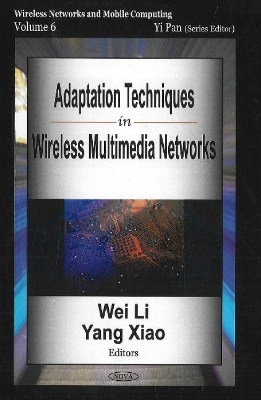
Adaptation Techniques in Wireless Multimedia Networks
Nova Science Publishers Inc (Verlag)
978-1-59454-883-3 (ISBN)
Next generation wireless and mobile communication systems have two important features: heterogeneity and adaptation. Heterogeneous wireless communication platforms require inter-operability among different networks such as wireless cellular networks, wireless local area networks, wireless personal area networks, internet, etc. Adaptation techniques become extremely important in such a heterogeneous environment so that quality management and provision to multimedia traffic over the unreliable wireless channels of the heterogeneous systems can satisfy the demands of various network users. With the development of multimedia compression and coding technologies, more and more real-time applications, such as video and audio can be made adaptive. Adaptation provides an alternative for resource planning, especially for bandwidth allocation/reallocation in wireless multimedia networks, where bandwidth is a scarce resource. The system may need to block incoming users if all of the bandwidth has been used up to provide the highest Quality of Service (QoS) to existing users. However, if these existing users can be degraded to a lower but acceptable QoS level, it is possible to reduce the blocking probability without degrading the QoS of existing users to an "unacceptable" level. Various approaches and algorithms adopting this idea have been proposed. It is therefore critical for wireless network designers to utilise these resources efficiently and effectively. In response to the above demand for next generation wireless and mobile communication systems, this book aims at providing a timely and concise reference of the current activities and findings in the relevant technical fields.
Preface; Link Adaptation Techniques For Carrier Sensed Multiple Access Based Wireless Local Area Networks; A Rate-Adaptive Multimedia Multicasting Mechanism in Multi-rate 802.11 Wireless LANs; Adaptation in the Physical Layer Using Heterogeneous Reconfigurable Hardware; Adaptive Video Multicast Over Wireless Internet; Adaptive QoS-based Bandwidth Allocation for Multimedia Wireless Networks; Adaptive Techniques For Robust Real-Time Video Communications; DCT-Based Audio Decomposition: Bandwidth Adaptation for Real-Time Audio Streams; Modelling Adaptive Self-Organising Wireless Networks: Methodology and Experiments; Optimal Downlink Resource Allocation For Cellular CDMA Networks; Adaptation of Wireless Mobile Multi-carrier Systems; Online Stochastic Optimisation of Wireless Multimedia Networks; Economic and Adaptive Admission Control of Non-stationary Traffic in Wireless Multimedia Networks; Modelling the Effects of Mobility on QoS in Wireless Multimedia Networks; Dynamic Channel Allocation Schemes in GPRS Networks; Multimedia Delivery Over Wireless Multi-hop Networks; Index.
| Erscheint lt. Verlag | 1.5.2007 |
|---|---|
| Zusatzinfo | Illustrations, unspecified |
| Verlagsort | New York |
| Sprache | englisch |
| Maße | 260 x 180 mm |
| Gewicht | 881 g |
| Themenwelt | Technik ► Elektrotechnik / Energietechnik |
| ISBN-10 | 1-59454-883-8 / 1594548838 |
| ISBN-13 | 978-1-59454-883-3 / 9781594548833 |
| Zustand | Neuware |
| Haben Sie eine Frage zum Produkt? |
aus dem Bereich


